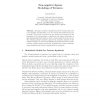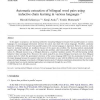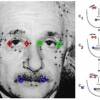53 search results - page 10 / 11 » A Non-convex Relaxation Approach to Sparse Dictionary Learni... |
CVPR
2010
IEEE
15 years 7 months ago
2010
IEEE
Many successful models for scene or object recognition transform low-level descriptors (such as Gabor filter responses, or SIFT descriptors) into richer representations of interme...
118
click to vote
SCALESPACE
2007
Springer
15 years 5 months ago
2007
Springer
This paper presents a statistical model for textures that uses a non-negative decomposition on a set of local atoms learned from an exemplar. This model is described by the varianc...
108
click to vote
IPM
2006
14 years 11 months ago
2006
In this paper, we propose a new learning method for extracting bilingual word pairs from parallel corpora in various languages. In cross-language information retrieval, the system...
ACL
2007
15 years 15 days ago
2007
Unsupervised learning of linguistic structure is a difficult problem. A common approach is to define a generative model and maximize the probability of the hidden structure give...
Publication
Image matching has been a central research topic in computer vision over the last decades. Typical approaches for correspondence involve matching features between images. In this p...



